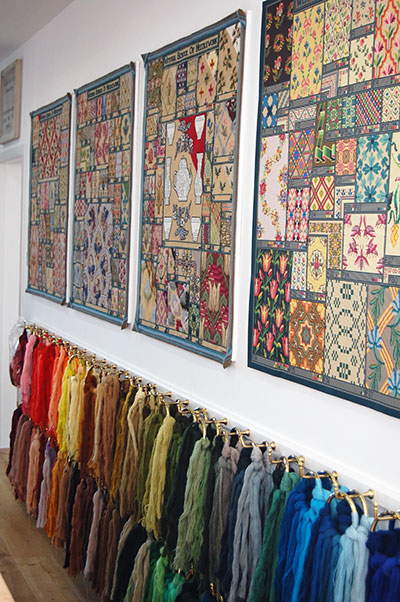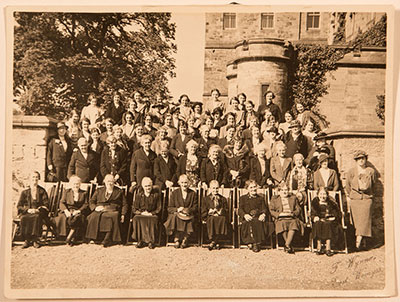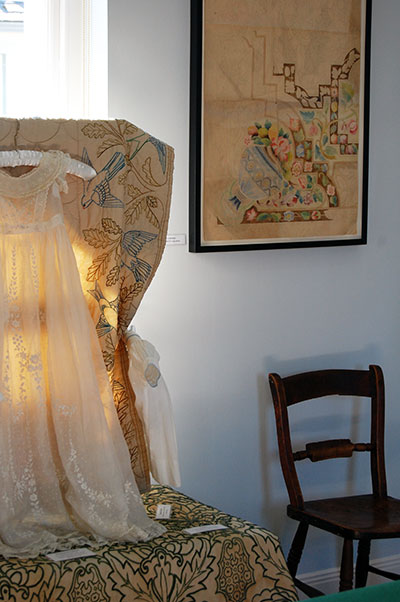Oh, ye’ll tak’ the high road, and I’ll tak’ the low road…
But whatever road you take, if you end up in Scotland, and if you love needlework and all things historical-needlework-related, perhaps you should schedule a stopover in Coaltown-of-Wemyss, perched just north of the Bonnie Banks of the Firth of Forth, to visit the Wemyss School of Needlework.
I recently wrote to the Wemyss School of Needlework to get on their newsletter mailing list. This led to an exchange of emails and an offer to write an article about them. You see, I find this little school and what it is doing now quite fascinating, and I think you’ll find it equally as fascinating. Hopefully, you can help me spread the word about it!
The Wemyss School of Needlework is perhaps not as well known as the Royal School of Needlework to the south; nevertheless, it has a worthy history, it houses an impressive historical collection, and it is recently “making a comeback” in needlework education.

Founded in 1877 at Wemyss Castle, the purpose of the Wemyss School of Needlework was to instruct the daughters of local miners and farmers in embroidery, so that they could find employment.
In 1880, the school moved to its present location in Coaltown-of-Wemyss, in Fife.

At its peak, an estimated 36 girls worked and studied at the school. The advent of the Second World War saw the school decline as students moved off to participate in war work.
It never recovered as a formal school, but the school itself and its collections were kept intact and cared for by the Wemyss family and the school’s seamstresses.

The school houses an exhibition space where visitors can view part of the school’s collection and archives of textiles, embroideries, and designs dating from as far back as the 17th century.
In the first two photos above, you can see a layout of textiles on display in the museum, including two caskets, and in the third photo, the first head mistress’s charming desk.

In addition to the museum, the School is turning back to its origins and becoming a school again!
This past year, several “taster” classes were successfully offered at the Wemyss School. They included classes in crewel work, silk shading, goldwork, and whitework.

If you weren’t there for the classes, the embroidery kits are available at the Wemyss School of Needlework website.

Ahhh – wool samplers on display! Do you need a cushion? A reupholstered chair? A kit to make your own? The school does bespoke work, too (commissioned work), drawing from a large archive of needlepoint designs that can be made up into kits for cushions, stools, rugs, pincushions.
Those samples on the wall would make stunning miniature canvases, don’t you think?

The Wemyss School has a wool wall, too! They stock needlework supplies, including Appleton wool, canvas, linens, and the like.

Besides reviving the educational aspect of the school, much work is being done to catalog the archives:
Another important task for us to complete is the cataloguing of our archive. A partial catalogue, written by Margaret Swain in 1984, forms the basis of this task. A fantastic volunteer recently spent a month here helping us to measure, describe and allocate a reference number to most of our pieces. This now needs formalising and every piece will be photographed so that we can assess the conservation requirements of the collection and also have a fully searchable database. We will then be able to curate our exhibitions effectively and allow people to browse the database to view items that aren’t currently on show as a special request. Currently we are working towards generating enough income to cover our running costs and then any surplus profits will be fed back into the care and conservation of the archive.

Working through the ledgers that date from the beginning of the school, they are slowly discovering and cross-reference data about what was stitched, by whom, and for whom.
If we can then add photographs and invoice records we can build up a picture of how the School ran, how busy they were, who visited and who work was made for. We know that pieces were made for members of the Royal Family including some of Queen Victoria’s children and later Queen Elizabeth the Queen Mother. We are now appealing for anyone who has visited the school or has connections to the school (perhaps through friends and family) to help us out with the missing pieces of this historical jigsaw puzzle.

We would love to have copies of photographs of the girls who learned and worked here either from then or later in their lives. We would also love images of any pieces made here and copies of any accompanying paper work. Accounts of any visits from abroad and any projects that were inspired by visits here would also be of great help to document the rich and lively story of the school.

The revival of the Wemyss School of Needlework is, in my opinion, such a bright, positive thing! It’s a good sign that the needle arts are alive and healthy.

Right now, there are some nice events scheduled at the School – including this Christmas class with Helen McCook and what sounds like some really fun “stitch ins” – social stitching gatherings where you bring your own project and stitch what you like, and drink coffee and tea and eat mince pies.
What could be more charming than stitching, socializing, drinking tea, and eating mince pies in December?!
There are limited spaces, so you have to book not only the class, but also the space at the stitch-in. If you’re in the area or will be traveling through in December, it’d be jolly fun! You should do it!

If you want to keep up with the news, you can add the Wemyss School of Needlework blog to your reading list, or you can contact them to be put on their newsletter mailing list.

I hope you enjoyed this brief look at the Wemyss School of Needlework. If you are ever traveling to Scotland, why not slot them into your itinerary and drop by to say howdy?
If you live in Northern England or other parts of Scotland and didn’t know about the school, maybe you could plan a day trip or an extended weekend to take in a class and visit the museum.
If, like me, you live far, far away, at least keep up with the news from the school. It’s exciting times for the endeavor and it will be fascinating to see how the future develops for the Wemyss School of Needlework!
Thanks very much to Louise Foster for the information and the photos!







What a wonderful post! I so enjoy learning about what others, around the world, are doing to promote conservation and interest in needlework. Thank you Mary.
Very well said! I, too, loved this post. Thanks, Mary!
G’day Mary,
Yes, it has been precious, still is precious and always will be precious to us interested in such things. Hope it all folds out beautifully to become a teaching school again. I would seem to have so much of importance to offer. Good going here Mary. Thank you,
Cheers, Kath
Typo there…meant ‘it would have so much to offer’. I certainly would be on the receiving end, not the offering end I’m afraid!
The Wemyss School is every bit as wonderful as it looks. I was there on an open day not so long ago, and was amazed and inspired by what was on exhibit. It certainly helped me imagine certain aspects of the stitching for a panel of the Great Tapestry of Scotland with which I was involved at the time. Fingers crossed that it makes a success of the classes — it would be absolutely wonderful to have access to such expertise in Scotland. Perhaps in time, whole courses might be available? We can dream!
Thanks for this, Mary. I’d love to go there in person some day.
Thank you Mary for directing us to the Weymss School. It is no secret that Scotland is my dream destination. I would never have learned about this school had it not been for you, Mary. What a little treasure and I want to help them to be successful.
Thanks for sharing Mary! I would love to view those tapestries up close. Would also love to look in those books and repair them.
How awesome! If my husband and I ever get the chance, Scotland is high on the list to visit – not least because his ancestral home, Dunnvegan Castle, is there, home to the McLeod Clan.
The framed picture of the 2 bird panels, above the small wooden chair –
do you suppose they are crewel work, or silk? Just stunning, and thanks
so much for sharing -what a treasure!
Mary,
Thank you for taking me to a site of history, industry and beauty.
Hi Mary. I live about 40 miles from this school and never knew it was there. I will be logging on for the news letter.
Thank you very much for this very interesting article…..on top of all your other ones as well.
Take care
Karen
Hi Mary,
Thank you so much for sharing this with us! It looks like a really lovely place and I wish them well in setting up their school. My husband and I visited Scotland six years ago so it’s unlikely we will go again, but one never knows!
My goodness, such a wonderful treasury of needlework and the people behind it. Oh, but wouldn’t a stitch-in there just be delightful. Thanks for bringing Weymiss to our attention.
Thanks Mary. What a great story. It’s so good that the textile arts generally are having such a renaissance. How on earth did you find this one? And does anyone know how to pronounce ‘Wemyss’ – I believe it is something like ‘Weems’ but it would be nice know for certain.
Yes, Christina, you have it exactly right: “Weems”. Even if you pronounce the two syllables really quickly together “We-miss”, you’ll only sound vaguely Scottish, which isn’t a bad thing at all!
So fun to read about the Wemyss school. I have several hankies that were embroidered by my great-grandma Nellie (from the Cille Mheàrnaig area in Scotland) and they are cherished items. She immigrated to America and raised ten children in Montana, so I have no idea when she found the time to embroider. Surely, there were times when she pined for home. One hankie is dark blue, red, and yellow silk plaid (similar to our family plaid) with a lovely embroidered scalloped edge and has “Frae Scotland” hand-embroidered on either side of a horseshoe atop some long-stalked white flowers. The second one is cream silk with a red plaid border and it has “Frae Bonnie Scotland” embroidered on it, along with the same type of flowers and a horseshoe. The silk has deteriorated a bit, but the embroidery is in great shape, and so tiny and precise.
Ah, she was from Kilmarnock in east Ayrshire (but I bet you knew that). I wonder if the handkerchiefs were from family weddings (or even her own?) — horseshoes and white heather being traditional symbols of good luck. What lovely momentos.
Thank you ..
Hi, referring back to this newsletter, I contacted them for courses this year and am pleased to say that on 27th this month I will be attending an “Or Nue” day course. I will report back and take photos. I am looking forward for a chance to see their records. My husband’s family were from this part of Fife back in the 17- early 1900’s.
I visited Wymess School of Needlework just after an article in a new stitching magazine. It was damp, there were holes in the floor and patterns strewn about. What stood out was the friendliness and generosity of the lady we met. I am looking forward to visiting again in the near future. It is super to see the photos of the school and to know it is secure. Especially delighted to know about the classes and hope to be a ‘student’very soon.
My aunt, Isabella Elder was a pupil at this school possibly around 1930 onwards. She became , according to family gossip, a part time teacher there and was also sent to the Carmelite nuns in Dysart to teach them embroidery.
Descendant of the designer of the Meldrum loom in Dunfermline. I connected with family when trying to find out about Scottish Quilts. Met Lesley Botton,have visited 3 times from Australia, and next time I will visit you!!
I only discovered the Weymss School of needlework through reading Clare Hunter’s book about Mary Queen of Scots. It is so nice to hear that you are Carrying on with the tradition.
Samples on the wall are lovely but I don’t understand how they would “make” stunning miniature canvases.
Nonetheless a great article